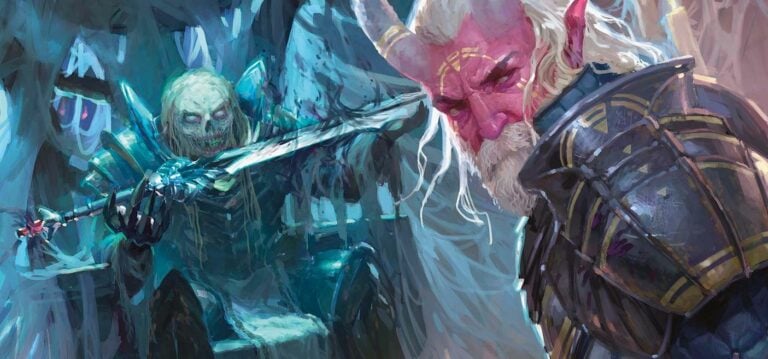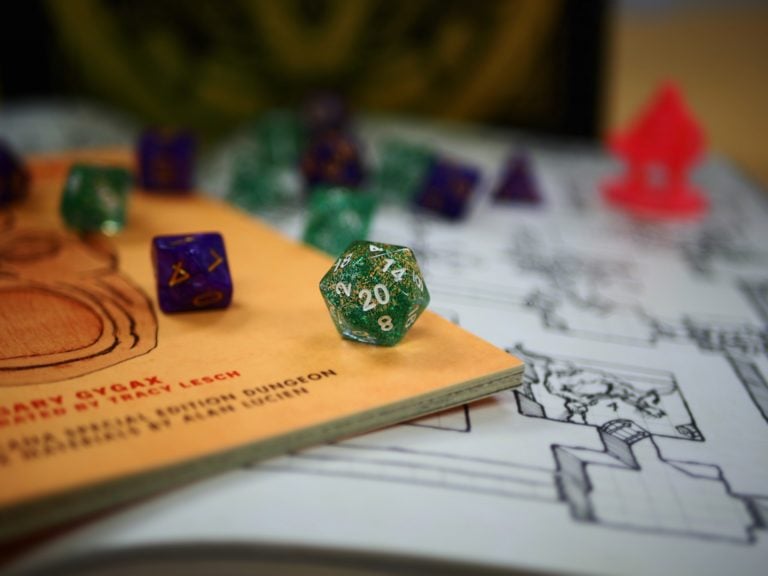Samurai 5E Guide | Fighter Samurai Subclass Guide
Xanathar’s Guide to Everything seems to have done a little more overseas research for inspiration for the Fighter. Within this tome live the Samurai, warriors who draw upon an unbreakable spirit to harm their enemies. Anyone who comes in the way of a Samurai will face an unrepentant foe, and steel tempered in the forge of the sun. However, this is no ordinary battlefield. Will the blade of the Samurai be of use to an adventuring party? Let’s find out with our Samurai 5E Guide.

Table of Contents
They Face Death: Samurai 5E
Short answer: Yes. The Samurai is a damage-dealing, all-out fighter subclass with a focus on a three times per day resource. By level 10, the resource becomes pseudo-infinite, allowing you to deal ridiculous damage and generate a surprising amount of hitpoints. If that wasn’t enough, this is also a fantastic ranged archetype, and Face potential that even rivals the Banneret, if there are enough Charisma and Wisdom items lying around.
Bonus Proficiency
To start, the Samurai get a tiny bit of flavor to season your build.
When you choose this archetype at 3rd level, you gain proficiency in one of the following skills of your choice: History, Insight, Performance, or Persuasion. Alternatively, you learn one language of your choice.
This is a free skill proficiency. Awesome! Fighters don’t get a lot of skills, so getting another skill on top of everything works well for you.
Before anything else, do not take the bonus language. Most classes can learn a spell that allows you to just understand languages, and then can do sign language or vague gestures to communicate back. At level 5, casters learn Tongues, and thus negate the need for language entirely. If you don’t have a caster who can learn a language, this may seem tempting, but you’re probably better off generally with one of the skill options.
History is super situational. You can use History checks to discern the backstory of an area, a person, or an event… and that’s mostly it. Sure, you can solve puzzles in some cases, but you probably don’t really care. Have a Wizard – or someone dedicated to Intelligence – handle History for you.
Performance is, sadly, in a similar boat as History. Performance is mostly used for generating small amounts of money from peasants. A creative GM might allow you to use Performance to dance your way out of a bad situation, but that’s entirely GM dependent. In most cases, being a stellar performer doesn’t help that much.
Your choice should likely be either Insight or Persuasion. Insight is good to have in general. It allows the GM an easy way to provide hints to the party, and it gives you something to do during social encounters. Persuasion proficiency synergizes with your level 7 ability, which turns you into an extremely valid Face. Consider getting both Insight and Persuasion through backgrounds and this!
Fighting Spirit
Also at level 3, you get your primary resource.
As a bonus action on your turn, you can give yourself advantage on all weapon attack rolls until the end of the current turn. When you do so, you also gain 5 temporary hit points. The number of hit points increases when you reach certain levels in this class, increasing to 10 at 10th level and 15 at 15th level.
You can use this feature three times. You regain all expended uses of it when you finish a long rest.
Unfortunately, this resource is daily. But trust me, at level 17, when you get advantage on 4 attacks per turn, this’ll feel great. Advantage on attack rolls is as good as it’s always been. The Fighter typically doesn’t benefit from Advantage, since they make so many attacks. However, this ability gives you advantage until the end of your turn.
Unfortunately, like so many Fighter builds, you need to expend a Bonus action to benefit from your ability. That limits your two-weapon fighting potential quite a bit, since having a Greatsword with advantage would benefit you more with Fighting Spirit. However, you could just two-weapon fight and perhaps have a backup weapon for when you proc Fighting Spirit, since it’s such a limited resource.
The bonus temporary hit points are a nice cherry on top. Since you don’t have a timer on it, that means these temporary hitpoints last until you take damage or until you rest. That’s a lot of bonus health! By level 15, you get 45 health whenever you completely spend your feature. Sure, it won’t tank a full hit, but it might be the difference between consciousness and unconsciousness.
This is a good time to mention that Action surge doesn’t end your turn and give you another one. It gives you another action. That means Fighting Spirit lasts through Action Surge.
Extremely powerful ability, limited only slightly by when you can get it back… though this is far too powerful to recover on a short rest!
Elegant Courtier
The Fighter is not well known for their ability to talk to people. Some would say Fighters are amongst the worst possible faces. Well, the Samurai wants to change that.
Starting at 7th level, your discipline and attention to detail allow you to excel in social situations. Whenever you make a Charisma (Persuasion) check, you gain a bonus to the check equal to your Wisdom modifier.
Your self-control also causes you to gain proficiency in Wisdom saving throws. If you already have this proficiency, you instead gain proficiency in Intelligence of Charisma saving throws (your choice).
What stellar bonuses!
It is entirely likely that your Charisma and Wisdom are both fairly low. You should try to make them positive if possible, especially your Wisdom. You can easily out-persuasion Sorcerers or other classes with good enough Charisma and Wisdom. Especially if you have the “set a stat to 19” items laying about!
This makes the Fighter a reasonable face while only needing to invest in Wisdom – the best non-caster mental stat. If you’re not looking forward to making the Charisma fighter, then you’ll at least be decent at talking to people.
Proficiency in Wisdom saves might be a Fighter’s best friend. Wisdom is one of three most potent saves – amongst Dexterity and Constitution. Unlike those two saves, Wisdom targets the player’s control of their character, and is super common in mid-to-late game casting slots. A Dominated Fighter becomes an absolute menace to your party. With Fighting Spirit, you can easily down an ally while under control of a GM. Thank goodness that that’s at least a bit harder now!
With Strength, Constitution, and Wisdom on your side, you’re now one of the more durable non-monk characters against casters. Good on you! Make sure to use Indomitable if you need to, though.
Tireless Spirit
At last, your Fighting Spirit’s daily limitation matters significantly less!
Starting at 10th level, when you roll initiative and have no uses of Fighting Spirit remaining, you regain one use.
Plan to use Fighting Spirit at least once per encounter now! This is a ridiculously powerful bonus to your number of times per day. By now, you’re one level off of swinging 3 times per turn. That means Fighting Spirit grants you advantage on three attacks, and 10 temp HP. That’s bananas! Every encounter can now fall under a cascade of advantage-boosted damage coming from you.
You may want to be careful with your default-given Fighting Spirit usage. Temporary hitpoints don’t stack, so maybe consider waiting on expending another Fighting Spirit if you still have temp HP left over.
Don’t let that stop you from rampaging on an important enemy, of course. They probably deserve it.
Rapid Strike
At level 15, you actually get an ability that strictly increases your damage potential… but, with a twist.
Starting at 15th level, you learn to trade accuracy for swift strikes. If you take the Attack action on your turn and have advantage on an attack roll against against one of the targets, you can forgo the advantage for that roll to make an additional weapon attack against that target, as part of the same action. You can do so no more than once per turn.
This is a pretty simple way to boost damage, and quite effective!
Essentially, you get to roll your advantage dice, and if both beat the opponent’s AC, you get to use both. That’s incredibly effective, and gives the Fighter 5 attacks per turn (6 with things like Haste or Two-Weapon Fighting) which is ludicrous!
So then, how do you get advantage on attacks? There’s the obvious Fighting Spirit, but that’s usually only once per fight. If your GM implements the Flanking bonus rule, then you’ve got another fairly simple way. Coming out of Stealth or Greater Invisibility can grant you advantage too. If your spellcasters have ways to debuff the enemy and grant advantage, then this is a pretty great addition to your toolkit! And hey, if a friend wants to run the Mastermind rogue archetype, this is a pretty good use of the feature. It’s essentially a Bonus Action to make the Fighter hit the person with a Greatsword again!
Strong ability, gives you incentive to look for Advantage wherever you can, and makes advantage great for Fighters.
Strength Before Death
The final ability of the Samurai will either kill you or make you look awesome. Or maybe both.
If you take damage that reduces you to 0 hit points, you can use your reaction to delay falling unconscious, and you can immediately take an extra turn. While you have 0 hit points during that extra turn, taking damage causes death saving throw failures as normal, and three death saving throw failures can still kill you. When the extra turn ends, you fall unconscious if you still have 0 hit points.
Once you use this feature, you can’t use it again until you finish a long rest.
This ability gives you a full turn after you’re knocked unconscious. That’s pretty stellar for so many reasons. Firstly, dying doesn’t matter at this point. That might sound cruel, but your Cleric, Bard, Paladin, Druid and even Sorcerer or Wizard can bring you back from the dead. Even if all your enemies decide to focus you down during Strength Before Death… that means they weren’t focusing down the Cleric or Paladin. You’ll be back with an action.
Secondly, if you’re willing to spend a Bonus Action, you may still have Second Wind. That means a Cleric doesn’t even need to spend an action on you, since you can heal yourself a fair amount. That means you’re no longer unconscious, you’ve succeeded on your death saves, and your enemies must start anew. That’s annoying!
Third, if you’ve still got Fighting Spirit, then your enemies must deal with, at minimum, 5 Fighter attack rolls (with 3 at advantage) before you go down. That’s usually devastating, to the point where this Strength Before Death turn can actively turn the tide of the fight.
Oh, also Action Surge exists. Consider using that to attack someone 9 times (7 with advantage!) during your Strength Before Death. Brutal.

Best Race for Samurai Fighters
Samurais are reasonable Strength or Dexterity builds. A Longbow doesn’t do significantly less damage than a Greatsword, and the Ranged Fighting Style is crazy good. If your party needs a ranged character, you can fill that role. In melee, Constitution is super important to stay alive (you don’t want to use Strength Before Death). At range, you still want to invest slightly into Constitution, but you’d be a bit more comfortable with Wisdom. Don’t want your allies having a bow turned on their back, right?
Bugbear
Weird choice, right? Maybe not. These Volo’s Guide monsters are our choice for a melee build. +2 Strength, +1 Dexterity is a slight waste, but you can ensure you don’t have negative Dexterity for the saving throws. Darkvision is great for any creature, Powerful Build gets you some packmule help…
And then there’s the stealth build. Sneaky and Surprise Attack combo well, allowing you to get the jump on an enemy and attack with 2d6 extra damage… at advantage. That means, at level 15, you get two chances to hit someone from stealth for Surprise Attack. Really weird build, but potentially great!
After turn 1, you get 10 foot reach with Greatswords. That increases your versatility in combat, letting you cover more room in a fight, especially in tight hallways. Really wacky, but it works well for getting that advantage.
Aarakocra
Thematically appropriate for a race of honorable warriors, the Aarakocra from the Elemental Evil Player’s Companion works well. With +2 Dexterity, +1 Wisdom, they’re exactly what you want for a ranged build. You also get to fly above the combat, which is nice when you have a bow in hand. Talons are… there. They can help you to grab things or make melee attacks with a bow in your hand. But that Fly speed is exactly why you pick up this race.
What is the Best Fighting Style for Samurai 5E?
You have some options when it comes to the way you build your samurai. In my view, the only approach I would avoid is a build centered on two-weapon fighting. This is because you’re going to have to give up that second attack any time you opt for Fighting Spirit. With that in mind, it is a great option for both two-handed as well as ranged weapons.
I like the defense fighting style if I’m going with a two-handed weapon build. You’re giving up a shield to do more damage, so bumping up your AC by one is especially helpful. Boosting your AC is also one of those things that is not always an option during the campaign. Of course, if you are going the two-handed weapon route, great weapon fighting is also an option if you prefer offense over defense.
Ranged attack samurai are suprisingly strong. When you can give yourself advantage at will thanks to Fighting Spirit, the archery fighting style suddenly becomes very tempting. You can create excellent synergy with a ranged build with you combine Fighting Spirit, the Sharpshooter feat, and the archery fighting style.
The Best Feats for a Samurai Fighter
Taking a feat can be tough for a fighter, especially if you are struggling to balance multiple ability scores. However, here are a few feats I like for the samurai if you choose to go in that direction.
Great Weapon Master
If you are a melee combat samurai, great weapon master is a good option. By focusing your character on big weapon attacks, you can really maximize your damage with this feat. Fighting Spirit also helps you offset the risk of missing on these attacks.
Sharpshooter
If you are planning a range-based samurai build, you can’t do any better than Sharpshooter. Giving up some of your attack roll isn’t great, but the tradeoff for more damage is worth it. This is especially a strong option for a Samurai fighter thanks to the Fighting Spirit feature.
Samurai 5E FAQ
What Book is the Samurai Subclass in 5E?
You can find the Samurai subclass in Xanathar’s Guide to Everything.
What is the Best Weapon for a Samurai in DND?
Unfortunately, katanas do not come standard in 5E D&D. With that in mind, arguably the best weapon for a samurai fighter is a greatsword that is reflavored to be a katana. Of course, your best option will be very different if you are a dexterity fighter build.
Is Samurai a DND Class?
Unlike other games, the samurai does not make up its own class in 5th Edition Dungeons and dragons. Instead, it is a subclass option for the fighter class.
How May Times Can You Use Fighting Spirit?
A samurai can use fighting spirit three times per day. You regain all of your uses of fighting spirit following a long rest.
Conclusion – Our Take on the Samurai
The Samurai is a stellar damage-dealing build. It has the potential to be any Fighter you want, and be tanky while doing so. This is one of the best options for your Fighter, and it does it while being extremely interesting and resource-based. Really fun choice for your Fighting needs!






